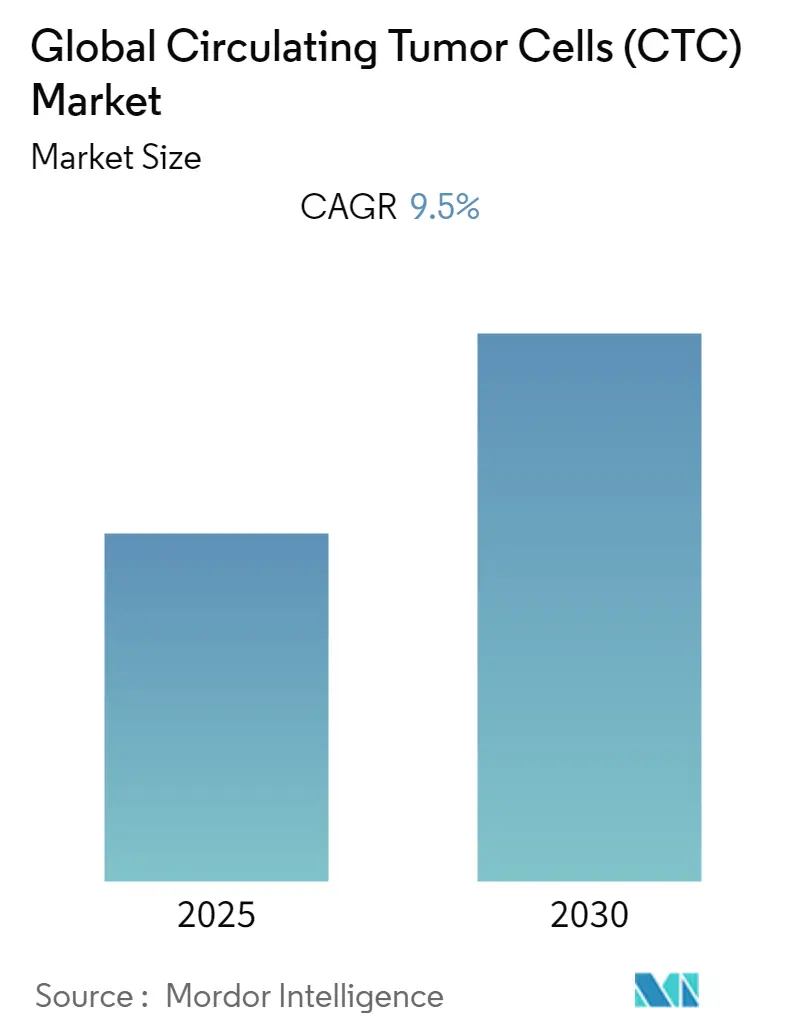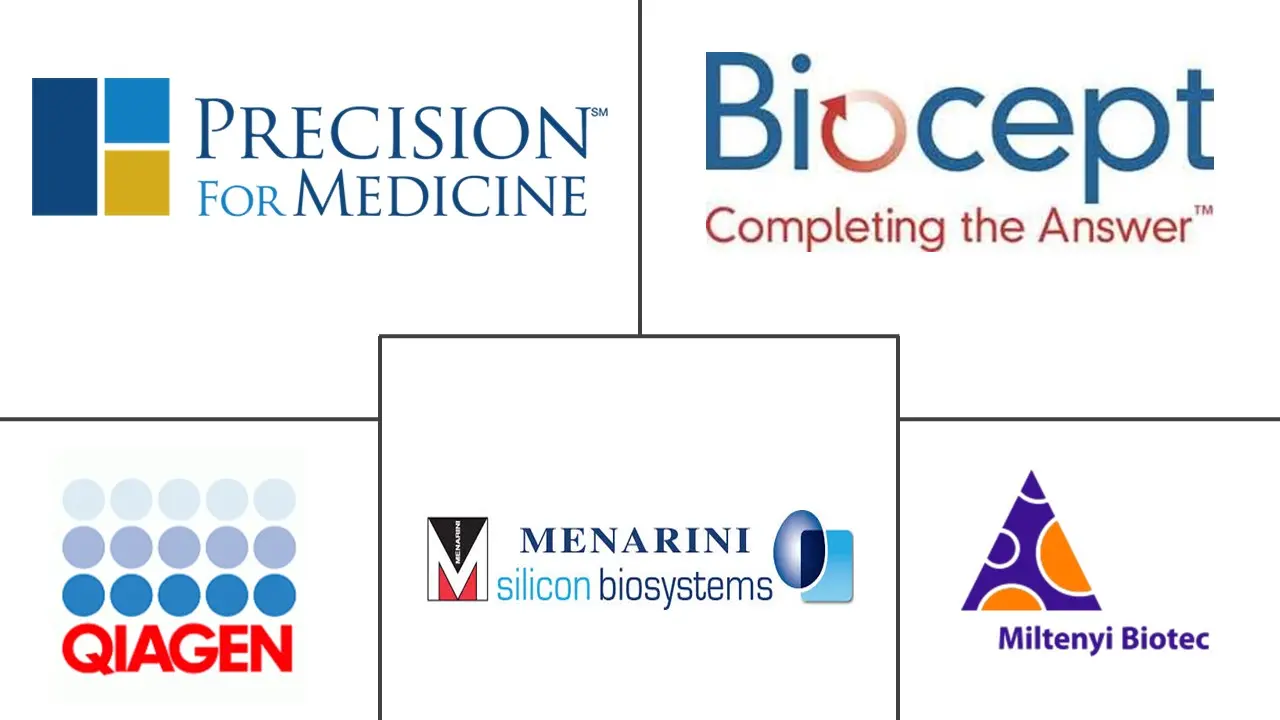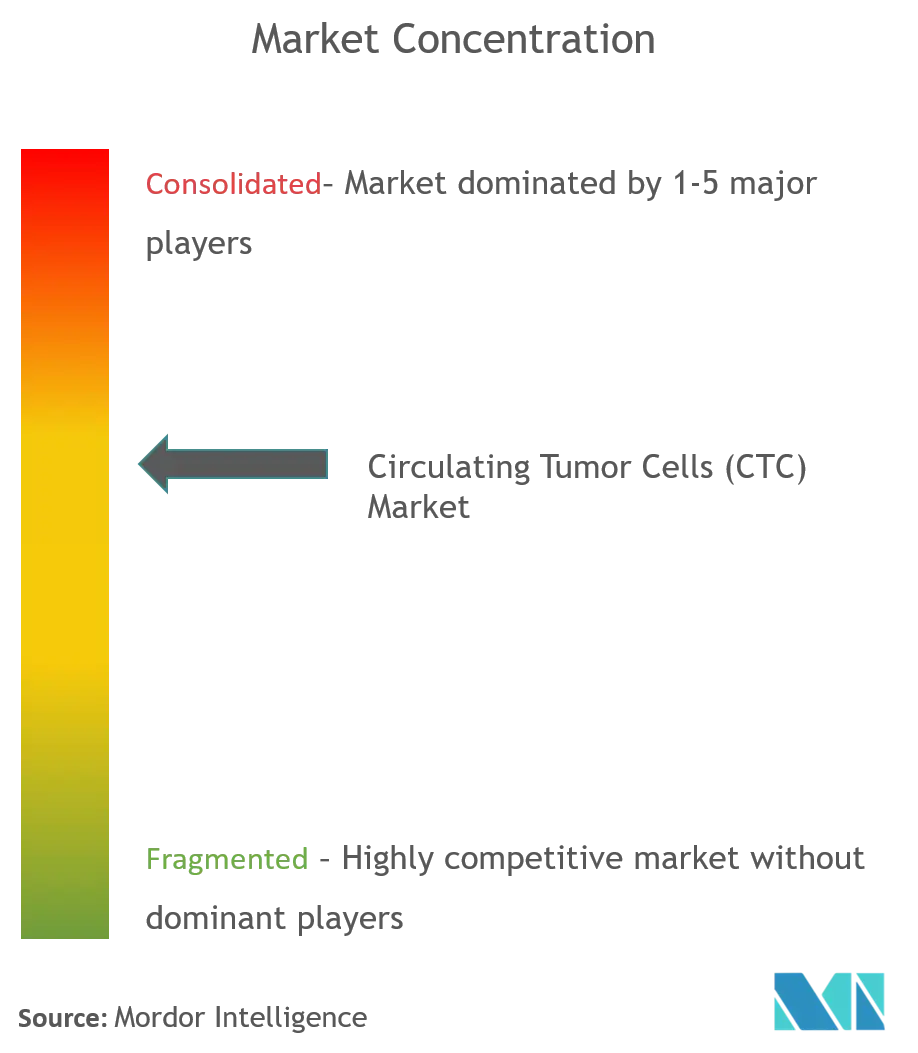
| Study Period | 2019 - 2030 |
| Base Year For Estimation | 2024 |
| Forecast Data Period | 2025 - 2030 |
| Historical Data Period | 2019 - 2023 |
| CAGR | 9.50 % |
| Fastest Growing Market | Asia-Pacific |
| Largest Market | North America |
Major Players
*Disclaimer: Major Players sorted in no particular order |
Circulating Tumor Cells (CTC) Market Analysis
The Global Circulating Tumor Cells Market is expected to register a CAGR of 9.5% during the forecast period.
The COVID-19 pandemic affected healthcare systems globally and resulted in the interruption of usual care in many healthcare facilities, exposing vulnerable patients with cancer to significant risks. For instance, a study titled "Impact of the COVID-19 Pandemic on Cancer Care: A Global Collaborative Study" in September 2020 reported that a total of 356 centers from 54 countries across six continents participated between April 21 and May 8, 2020. These centers serve 716,979 new patients with cancer every year. Most of them (88.2%) reported facing challenges in delivering care during the pandemic. Although 55.34% reduced services as part of a preemptive strategy, other common reasons included an overwhelmed system (19.94%), lack of personal protective equipment (19.10%), staff shortage (17.98%), and restricted access to medications (9.83%). Thus, this indicates that due to COVID-19, there were disruptions in cancer care regarding reduced chemotherapy and radiotherapy services and ongoing research and development studies, thereby impacting the market growth.
Additionally, the study "Association of COVID-19 Lockdown With the Tumor Burden in Patients With Newly Diagnosed Metastatic Colorectal Cancer," published in September 2021, evaluated the effect of COVID-19-induced lockdown on newly diagnosed colorectal cancer cases through circulating tumor DNA and reported that tumor burden in patients who received a diagnosis after the lockdown was significantly higher compared with those who were diagnosed before the lockdown. This study indicated that the tumor burden increased during COVID-19 significantly and thus dramatically impacted the market growth.
The major factors for the growth of the circulating tumor cells (CTC) market include the advancements in biomedical imaging and bioengineering technology; the rising demand for preventive medicine and companion diagnostics; and the growing prevalence of cancer.
The global cancer burden is increasing; thus, cancer therapies must be modified according to regional and national priorities. For instance, according to the September 2021 update by the World Health Organization (WHO), cancer accounted for approximately 10 million worldwide deaths in 2020. The most common in 2020 (in terms of new cases of cancer) were: breast (2.26 million cases); lung (2.21 million cases); colon and rectum (1.93 million cases); prostate (1.41 million cases); skin (non-melanoma) (1.20 million cases); and stomach (1.09 million cases).
In addition, as per the 2020 statistics by Globocan, 19,292,789 people were diagnosed with cancer in 2020. As per the same source mentioned above, the number of people with cancer is estimated to reach 30.2 million by 2040. The increasing cancer burden is due to several factors, such as population growth and aging and the changing prevalence of specific causes of cancer linked to social and economic development. For instance, as per the World Health Organization (WHO), in September 2021, about one-third of deaths from cancer are due to tobacco use, high body mass index, alcohol use, low fruit and vegetable intake, and lack of physical activity. Thus, increasing tobacco consumption is expected to cause an increase in the prevalence of cancer, thereby contributing to market growth.
Moreover, the positive results from the recent clinical studies in the market may also boost and lead to significant market growth in the future. For instance, a study titled "Heat Shock Protein (HSP) 70 to Quantify and Characterize Circulating Tumor Cells in Patients With Advanced or Metastatic Tumors" was initiated in February 2021 to evaluate the ability of heat shock protein HSP70 to isolate and quantify circulating tumor cells (CTCs) in patients with advanced or metastatic tumors.
Thus, owing to the factors above, the studied market is expected to grow significantly during the study period. However, technical difficulties in the detection and characterization of CTCs associated with the high cost of diagnosis, lack of awareness, and unwillingness to adopt advanced CTC technologies are expected to hamper the market's growth further.
Circulating Tumor Cells (CTC) Market Trends
The Negative Enrichment Segment is Expected to Hold a Major Market Share in the Circulating Tumor Cells (CTC) Market
In the case of the positive enrichment method, it cannot isolate CTCs depending on heterogeneous properties. However, the negative enrichment method can isolate heterogeneous and intact CTCs by precisely eliminating blood cells. Thus, such an advantage of negative enrichment technology is expected to increase its adoption over the coming years.
Moreover, the rising prevalence of the various types of cancer is anticipated to bolster the segment's growth in the near future. According to the International Agency of Research on Cancer, 2020 Statistics, liver cancer was the sixth most common cancer and the third leading cause of cancer deaths worldwide, with an estimated 905,677 new cases and 830,180 deaths. East Asia had the highest incidence, with 491,687 cases. Moreover, the incidence rate was 46,599 in North America and 26,128 in western Europe. Overall, the incidence rate of liver cancer is approximately three times higher in males than in females.
Furthermore, according to an article published by the American Cancer Society in January 2022, kidney cancer is among the ten most common cancers in both men and women in the United States. Overall, the lifetime risk for developing kidney cancer in men is about 1 in 46, and in women is about 1 in 80, which is significantly high. Cancer prevention is one of the most significant challenges with this growing burden. The analysis of circulating tumor cells is a substantial aspect of monitoring disease progression or response to treatment, specifically as a companion diagnostic for new anticancer drugs and research into the mechanisms of disease progression.
In addition, negative enrichment has advantages over positive enrichment in isolating CTCs, owing to which the segment is expected to witness high growth over the forecast period. For instance, the study titled "Negative enrichment of circulating tumor cells from unmanipulated whole blood with a 3D printed device," published in October 2021, stated that the negative enrichment approach is advantageous because it leads to the unbiased detection of CTCs and also produces intact tumor cells free of attached immuno-agents, eliminating potential artifacts in downstream studies. Thus, the market segment is expected to grow significantly with the advantages of negative enrichment methods over other enrichment technologies.
Thus, the studied segment is expected to contribute significantly to the market's growth owing to the abovementioned factors.

North America is Expected to Hold a Significant Share in the Market and Expected to do Same in the Forecast Period
North America is expected to contribute to the significant growth of the market owing to factors such as the increasing burden of cancer, product approvals, and rising research and development activities. For instance, according to the estimates of the 2022 American Cancer Society, Inc., about 236,740 new cases of lung cancer will be diagnosed in the country in 2022. The same source also states that 79,000 new cases of kidney cancer and 13,920 deaths will be reported in 2022 from kidney cancer. The high burden of cancer is expected to boost the demand for CTC detection kits, thereby driving market growth.
Additionally, product approvals in the studied market are further expected to drive market growth. For instance, in November 2020, the Food and Drug Administration (FDA) expanded the approved uses for a blood test, known as a liquid biopsy, that can help doctors pick the best treatments for some people with cancer. The test identifies cancer-related genetic changes in DNA from tumor cells released into the blood.
Moreover, according to a study, "Cancer cells alter protein production machinery to hasten metastasis," published in February 2020, CTCs enriched from the blood of breast cancer patients have higher levels of ribosomal proteins (RP), and their presence is associated with increased disease aggressiveness and poor clinical outcomes. Thus, studies evaluating the presence of ribosomal proteins in CTCs will lead to an effective cancer diagnosis, thus driving the market. In addition, the United States has one of the most successful products, the CellSearch Circulating Tumor Cell Kit, which is approved by the US Food and Drug Administration (FDA). The product has reimbursement facilities through various public and private payers in several states, such as Cigna Government Services, Noridian, and United Healthcare. Several universities across the United States have relied on CTCs applications to advance the practice of pathology and laboratory medicine.
Thus, the market studied is expected to witness high growth over the forecast period owing to all the factors above.

Circulating Tumor Cells (CTC) Industry Overview
The market studied is a moderately consolidated market, owing to the presence of small and large market players. Some market players are Advanced Cell Diagnostics Inc., Aviva Biosciences, Biocept Inc., Creatv Micro Tech, Inc., LungLife AI Inc., Menarini Silicon Biosystems, and Miltenyi Biotec, Precision For Medicine (Formerly ApoCell), and Qiagen NV.
Circulating Tumor Cells (CTC) Market Leaders
-
Menarini Silicon Biosystems
-
Miltenyi Biotec
-
Precision For Medicine (Formerly ApoCell)
-
Qiagen NV
-
Biocept Inc
- *Disclaimer: Major Players sorted in no particular order

Circulating Tumor Cells (CTC) Market News
- In July 2021, Datar Cancer Genetics reported the publication of a MedTech Innovation Briefing (MIB) from the United Kingdom's National Institute for Health and Care Excellence (NICE) on its CE-marked 'Trueblood-Prostate' test to be used for precision triaging of patients to avoid unnecessary invasive biopsies.
- In February 2021, Menarini Silicon Biosystems launched a CellMag product line for the manual enrichment and staining of rare circulating tumor cells (CTCs).
Circulating Tumor Cells (CTC) Industry Segmentation
As per the scope of this report, circulating tumor cells (CTC) refer to the tumor cells that air inside the body through the blood circulatory system and lymphatic system. Factors such as the high prevalence of cancer, advancements in biomedical imaging and bioengineering technology, increased demand for preventive medicine, and the need for companion diagnostics drive the circulating tumor cells market globally. The Circulating Tumor Cells (CTC) Market is segmented by Technology (CTC Enrichment Methods and CTC Detection Methods), Application (Multiple Chromosal Abnormalities, RNA Profiling, Protein Expression, Cellular Communications, and Other Applications), and Geography (North America, Europe, Asia-Pacific, Middle East, and Africa and South America). The market report also covers the estimated market sizes and trends for 17 countries across major global regions. The report offers the value (USD million) for the above segments.
| By Technology | CTC Enrichment Methods | Positive Enrichment |
| Negative Enrichment | ||
| Other Technologies | ||
| By Technology | CTC Detection Methods | Immunocytochemical Technology |
| Molecular (RNA)-based Technology | ||
| Other CTC Detection Methods | ||
| By Application | Multiple Chromosome Abnormalities | |
| RNA Profiling | ||
| Protein Expression | ||
| Cellular Communication | ||
| Other Applications | ||
| Geography | North America | United States |
| Canada | ||
| Mexico | ||
| Geography | Europe | Germany |
| United Kingdom | ||
| France | ||
| Italy | ||
| Spain | ||
| Rest of Europe | ||
| Geography | Asia-Pacific | China |
| Japan | ||
| India | ||
| Australia | ||
| South Korea | ||
| Rest of Asia-Pacific | ||
| Geography | Middle-East and Africa | GCC |
| South Africa | ||
| Rest of Middle-East and Africa | ||
| Geography | South America | Brazil |
| Argentina | ||
| Rest of South America |
Circulating Tumor Cells (CTC) Market Research FAQs
What is the current Global Circulating Tumor Cells (CTC) Market size?
The Global Circulating Tumor Cells (CTC) Market is projected to register a CAGR of 9.5% during the forecast period (2025-2030)
Who are the key players in Global Circulating Tumor Cells (CTC) Market?
Menarini Silicon Biosystems, Miltenyi Biotec, Precision For Medicine (Formerly ApoCell), Qiagen NV and Biocept Inc are the major companies operating in the Global Circulating Tumor Cells (CTC) Market.
Which is the fastest growing region in Global Circulating Tumor Cells (CTC) Market?
Asia-Pacific is estimated to grow at the highest CAGR over the forecast period (2025-2030).
Which region has the biggest share in Global Circulating Tumor Cells (CTC) Market?
In 2025, the North America accounts for the largest market share in Global Circulating Tumor Cells (CTC) Market.
What years does this Global Circulating Tumor Cells (CTC) Market cover?
The report covers the Global Circulating Tumor Cells (CTC) Market historical market size for years: 2019, 2020, 2021, 2022, 2023 and 2024. The report also forecasts the Global Circulating Tumor Cells (CTC) Market size for years: 2025, 2026, 2027, 2028, 2029 and 2030.
Our Best Selling Reports
CTC Industry Report
Statistics for the 2025 Global Circulating Tumor Cells (CTC) market share, size and revenue growth rate, created by Mordor Intelligence™ Industry Reports. Global Circulating Tumor Cells (CTC) analysis includes a market forecast outlook for 2025 to 2030 and historical overview. Get a sample of this industry analysis as a free report PDF download.




